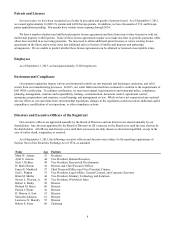Crucial 2015 Annual Report Download - page 20
Download and view the complete annual report
Please find page 20 of the 2015 Crucial annual report below. You can navigate through the pages in the report by either clicking on the pages listed below, or by using the keyword search tool below to find specific information within the annual report.18
Compliance with regulations regarding the use of conflict minerals could limit the supply and increase the cost of
certain metals used in manufacturing our products.
Increased focus on environmental protection and social responsibility initiatives led to the passage of Section 1502 of the
Dodd-Frank Wall Street Reform and Consumer Protection Act of 2010 (the "Dodd-Frank Act") and its implementing Securities
and Exchange Commission regulations. The Dodd-Frank Act imposes supply chain diligence and disclosure requirements for
certain manufacturers of products containing specific minerals that may originate in or near the Democratic Republic of the
Congo (the "DRC") and finance or benefit local armed groups. These "conflict minerals" are commonly found in materials
used in the manufacture of semiconductors. The implementation of these new regulations may limit the sourcing and
availability of some of these materials. This in turn may affect our ability to obtain materials necessary for the manufacture of
our products in sufficient quantities and may affect related material pricing. Some of our customers may elect to disqualify us
as a supplier or reduce purchases from us if we are unable to verify that our products are DRC conflict free.
We may incur additional tax expense or become subject to additional tax exposure.
We operate in a number of locations outside the U.S., including in Singapore, and, to a lesser extent, Taiwan, where we
have tax incentive agreements that are, in part, conditional upon meeting certain business operations and employment
thresholds. Our domestic and international taxes are dependent upon the distribution of our earnings among these different
jurisdictions. Our provision for income taxes and cash tax liabilities in the future could be adversely affected by numerous
factors, including challenges by tax authorities to our tax structure, income before taxes being lower than anticipated in
countries with lower statutory tax rates and higher than anticipated in countries with higher statutory tax rates, changes in the
valuation of deferred tax assets and liabilities, failure to meet performance obligations with respect to tax incentive agreements,
and changes in tax laws and regulations. We file income tax returns with the U.S. federal government, various U.S. states, and
various other jurisdictions throughout the world. Our U.S. federal and state tax returns remain open to examination for 2011
through 2015. In addition, tax returns open to examination in multiple other taxing jurisdictions range from the years 2007 to
2015. The results of audits and examinations of previously filed tax returns and continuing assessments of our tax exposures
may have an adverse effect on our provision for income taxes and cash tax liability.
We may not utilize all of our net deferred tax assets.
We have substantial deferred tax assets, which include, among others, net operating loss and credit carryforwards. As of
September 3, 2015, our U.S. federal and state net operating loss carryforwards, including uncertain tax benefits, were $4.02
billion and $2.05 billion, respectively, which, if not utilized, will expire at various dates from 2016 through 2035. As
of September 3, 2015, our foreign net operating loss carryforwards were $5.15 billion, including $3.81 billion pertaining to
Japan, which, if not utilized, substantially all will expire at various dates from 2017 through 2025. As of September 3, 2015,
we had valuation allowances of $1.16 billion and $710 million against our net deferred tax assets in the U.S. and Japan,
respectively.
The limited availability of raw materials, supplies, or capital equipment could materially adversely affect our business,
results of operations, or financial condition.
Our operations require raw materials, and in certain cases, third party services, that meet exacting standards. We generally
have multiple sources of supply for our raw materials and services. However, only a limited number of suppliers are capable of
delivering certain raw materials and services that meet our standards. In some cases, materials, components, or services are
provided by a single supplier. Various factors could reduce the availability of raw materials or components such as silicon
wafers, controllers, photomasks, chemicals, gases, photoresist, lead frames, and molding compound. Shortages may occur from
time to time in the future. We and/or our suppliers could be affected by laws and regulations enacted in response to concerns
regarding climate change, which could increase the cost and limit the supply of our raw materials. In addition, disruptions in
transportation lines could delay our receipt of raw materials. Lead times for the supply of raw materials have been extended in
the past. If our supply of raw materials or services is disrupted or our lead times extended, our business, results of operations,
or financial condition could be materially adversely affected.
























